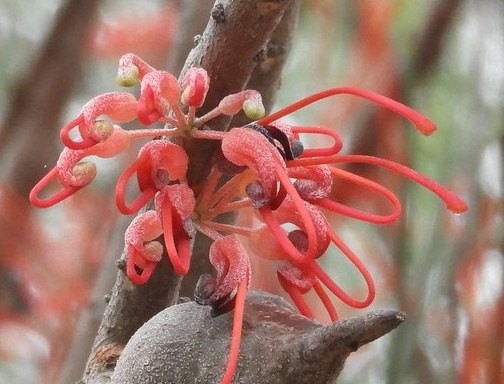Hakea purpurea
(Hakea purpurea)

Description
Hakea purpurea is a flowering plant in the family Proteaceae shrub and grows in Queensland and New South Wales. It is a small shrub with needle-shaped leaves and clusters of red flowers in late winter to early spring. Hakea purpurea is a dense, upright, slightly spreading shrub 0.3–3 m (1–10 ft) high and 1 m (3 ft) wide. The branchlets are either smooth or with flattened, silky hairs. The leaves are needle-shaped and divide toward the apex into 2-7 segments that are 1.6–9.5 cm (0.63–3.74 in) long and 0.8–1.5 mm (0.031–0.059 in) wide and end in a sharp point 1–2 mm (0.039–0.079 in) long. The leaves are thickly covered in short, matted, white or rusty coloured hairs quickly becoming smooth. Profuse reddish-purple flowers up to 3 cm (1 in) long appear in spring in thick clusters in the leaf axils, sometimes on old wood. These are followed by smoothish ovoid woody seed capsules that are approximately 1.5 cm (0.6 in) wide ending with an upturned beak. Hakea purpurea was first formally described by William Jackson Hooker in 1848 and published the description in Journal of an Expedition into the Interior of Tropical Australia. Derived from the Latin purpureus meaning 'purple' or 'dull red with a tinge of blue' a reference to the colour of the flowers. Hakea purpurea occurs in central Queensland and has an isolated occurrence in hills north of Yetman in New South Wales. Grows in open forest, woodland and heath, mostly in sandy soil. A very showy species good for garden cultivation. Tolerant of fairly heavy frosts and attractive to nectar eating birds. Plants in the genus Hakea are shrubs or small trees. Some species have flat leaves, whilst others have leaves which are needle-like, in which case they are sometimes divided and sometimes have a groove on the lower surface. The flowers are arranged in groups in leaf axils and are surrounded by bracts when in bud. The flowers have both male and female parts and are borne on a short stalk called a pedicel. The sepals and petals, jointly called tepals, form a curved tube which sometimes splits open as the flower develops. The style is longer than the tepal tube and is curved before its tip is released. When released, the tip of the style is a pollen-presenter. The fruit of hakeas is woody and persists on the plant until burned in a bushfire or until the plant dies. The fruit then splits open to release two winged seeds.
Taxonomic tree:







